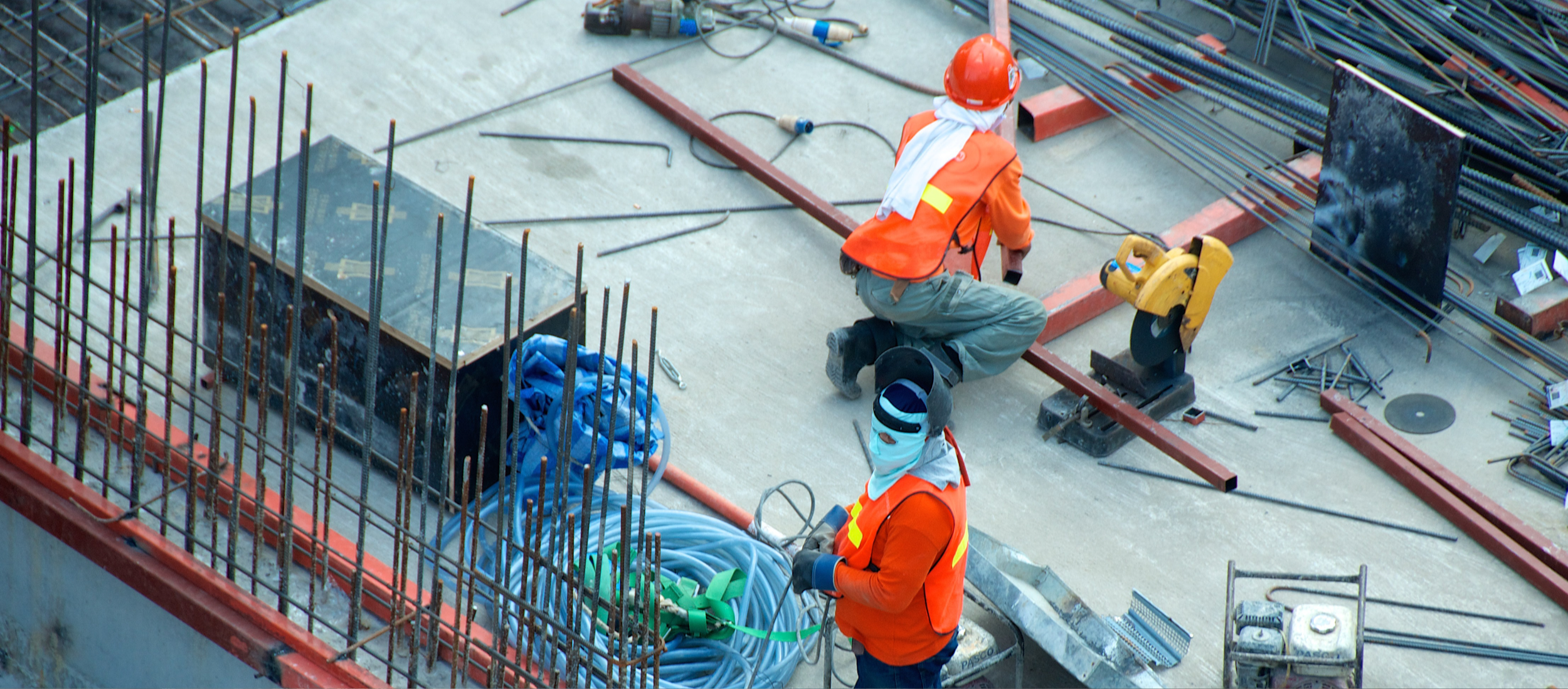Building the Future with Technology
Digitalization in the construction industry
02/17/2020 – Daniel Planert

The construction industry still has a lot of catching up to do when it comes to digitalisation. Sounds tedious, but it can be a pretty hot potato: In London there is the "Walkie Talkie Building", whose glass facade catches the sun like a concave mirror and reflects it onto the street. In 2013, this caused cars to melt. Instead of a calculated 36 degrees, the rays reached up to 72 degrees Celsius.
"I knew this could happen," architect Rafael Viñoly told the Guardian at the time. According to Viñoly, when the building was constructed (from 2009), there was no software that could have adequately analyzed the problem. However, visualizers that re-modelled the construction project using software had predicted the problem. In Germany, too, construction projects occasionally have to be modified because only the visualization, which is primarily used for marketing purposes, reveals construction errors during the construction phase.
This "principle of chance" in construction has no future in Europe. The construction industry is aware that it must invest in digital technology and processes. There is no other way to meet the increasing demand for living space, nor can costly chains of error such as those at BER Airport or the Elbe Philharmonic Hall in Hamburg be avoided.
Up to 90 percent of public construction contracts are already being tendered electronically, and the EU is actively promoting digital tendering for reasons of efficiency. However, many construction companies still use paper, telephone and fax, according to the management consultancy Roland Berger in 2017. Digitalization will soon become a key issue for all players in the value chain. From planning to material suppliers to unskilled workers.

BIM: Planning/Building 4.0
When the construction industry talks about digitalization, it usually means "Building Information Modeling (BIM)". This is a complete, digital 3D model of the building with all planning and construction data. Prior to construction, the entire building project is digitally simulated. In the future, BIM will be a central tool for the complete lifecycle management of a building: From planning, construction and completion, marketing and maintenance to demolition.
This could help to avoid costly misplanning in the future, such as at Berlin Airport. Various software solutions are currently offered for the open standard, most of which also include cloud functions. According to its own presentation, Autodesk is the leading provider of openBIM solutions, which are designed to ensure the smooth exchange of data between the software offerings of different manufacturers. However, many companies have been working in so-called "closedBIM" systems, which do not yet offer exactly this advantage.
In a joint statement, the construction industry associations stated that Germany was about five years behind in the introduction of BIM in a global comparison. Politics is now accelerating: from 2020, public infrastructure projects in Germany are to be built using BIM alone. The Federal Ministry of Transport and Digital Infrastructure hopes that this will lead to new quality standards and greater efficiency. However: According to a study by the Fraunhofer Institute, less than a third of the construction industry will still be using BIM in 2017. Another 10 percent planned to introduce it. Architects and engineers are also having to make massive changes - similar to the early 1980s, when CAD systems replaced the classic drawing board. The Bavarian Chamber of Architects estimates that only 5% of German architects will be working with BIM in 2017.
So for the near future, the following applies: Those who do not work with BIM risk massive competitive disadvantages. This is because communication with it will be more time-consuming, more coordination-intensive and therefore more expensive. Most of those involved now understand this. According to Roland Berger 2017, only just over 30% of the construction industry was convinced by BIM. According to a survey by PwC 2018, more than half were. All in all, concrete implementations were still a long time coming. However, Roland Berger expects the market for BIM applications to quadruple between 2014 and 2022: from USD 2.7 billion to around USD 11.5 billion.

Procurement and Logistics
Evaluate building materials by fax price list and order by phone? Many companies have now understood that this is not efficient. The Swedish construction group Skanska, for example, already uses a digital platform for 40 percent of its material procurement. The construction machinery manufacturer Hilti uses electronic catalogues for its purchasing. According to Roland Berger, this alone saves 5-10 percent of costs.
The production of building materials offers enormous potential; even today, it is still carried out predominantly with classical methods. This starts with digital logistics, continues with the automation of production and ends with quality control and delivery.
First examples show that digital services can create added value and thus increase customer loyalty: Insulation specialist Rockwool, for example, offers an app aimed at architects, tradesmen and building material retailers. Using building data and current energy prices, anyone can calculate the savings potential of building insulation. This often leads to a decision about such a project.
Digitalizing the construction site
Just about every construction worker should have a mobile phone. But that doesn't make a digital construction site. According to Roland Berger, only about 30 percent of the working time on a construction site is spent on the workers' actual tasks. They spend most of their time on routes, transportation or searching for materials and tools.
This immediately reveals the potential that lies in a "just-in-time" delivery of materials, for example, along the lines of industrial production. An excavator could use the Internet of Things to call an available truck when it is needed. The truck finds out via the network when and where which construction material is needed. Such GPS-based IoT systems could massively increase efficiency in construction, but are far from being standard. The building materials manufacturer Cemex, for example, offers the option of measuring the cement level in the container digitally and refilling it if necessary without the customer having to do anything.
Some construction project managers spend 90 percent of their working time on communication. Here, cloud solutions could significantly increase effectiveness by making relevant data immediately available to all project participants.
Construction site surveying using 3D lasers is becoming increasingly popular. They not only survey, but also find water and power lines and automatically feed this data into planning tools.

Robotics and 3D Printing
Robotics and 3D printing can massively reduce construction costs and construction time, as examples outside Europe show. Construction robot "Hadrian" is in use in Australia. It is fed with 3D construction plans and can build a house in 48 hours. 3D printers use construction plans to produce parts of buildings made of cement and the like – directly on the construction site. Some construction companies in China work in this way. In China, it takes two days to "print" an apartment building, and construction time is reduced by 80 percent.
According to the Federal Office for Goods Transport, theft on construction sites causes 138 million euros in damage every year. Telecommunications companies are working on solutions here, but only some of them are ready for series production. Vodafone presented a complete IoT construction site at Cebit 2018. Cranes, for example, are remotely controlled centrally via a 5G network. Helmets report vibrations to a health service. A networked fence reports when it is knocked over or damaged.
A welding robot that is controlled by a worker via an app has already been tested in track construction. It produces a smooth rail connection and simultaneously monitors the optimum welding temperature.
Renovations: Digital does not equal agile
In the housing industry, the beginnings of digitisation go back a long time. A Berlin housing association, for example, wanted to move the complete apartment-related renovation process for tenant changes to a digital platform back in 2008. The goal: The project manager documents the condition of the apartment on the platform and commissions the craftsman to do it. Then, the craftsman uses the platform to directly bill the tenant based on a standardized price list.
The mapping of all contingencies in the specification sheet led to a project duration of several years and a solitary solution that is difficult to scale. Agile development methods and an MVP approach can lead to the goal faster and more efficiently. Already 10 years earlier, the housing industry had increasingly relied on the digital handover protocol filled out by hand-held computer. In the context of BIM and smart buildings, the focus today is no longer on digitally replicating analog and partially analog processes. By means of Big Data and Predictive Maintenance, more efficient processes should be created from the outset.
No going back
The path to the digital future has already been taken, at the request of politicians and professional associations – and against the background of international competition, which has overtaken the German construction industry in some areas. There will be no going back. Players in the construction industry and real estate management can no longer afford to do without digital expertise. From tendering to maintenance by means of smart building technology – those who refuse to comply with the new standards will run the risk of losing their competitiveness in the coming years.

